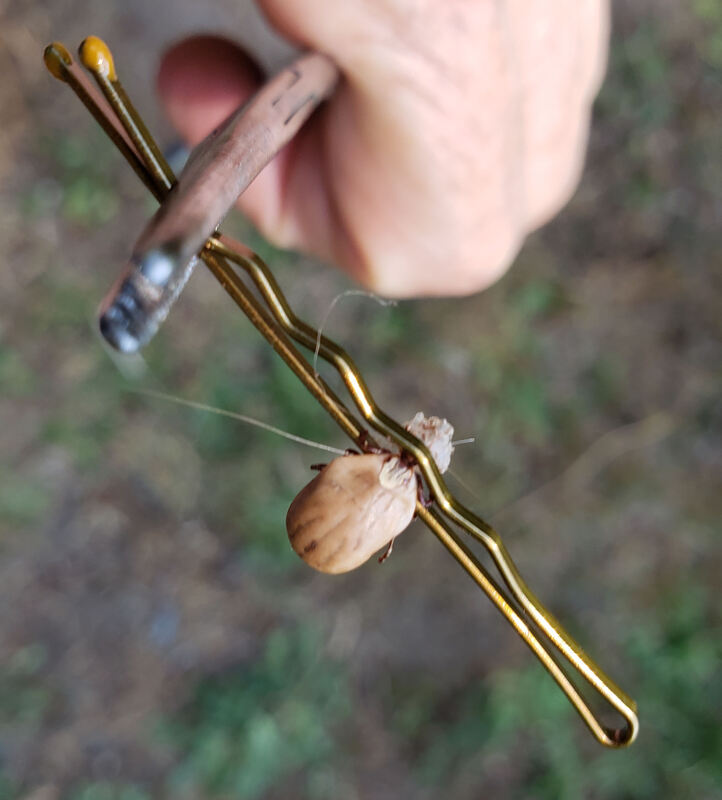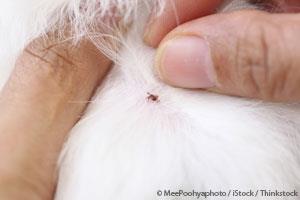|
I am staying in a wooded area of Western Washington and they do have ticks. I have taken three off of my dog this past week. The other two were really close to her eye and easy to see right away before the really anchored into the skin.
I just watched this video on Facebook and then was sitting outside while checking my dogs ears and I found another tick. This Tick was a bit bigger so I went and got my bobby pin and followed this guide. It came out very easy. It was also very easy to get under the head of the tick so the entire body was removed from my dog. I realized after that I should have taken a picture of the tick before I removed it but I just wanted it off of my dog.
0 Comments
This is great information on ticks and how to prevent your pet's from Lime disease and other Tick related issues. If you want information on essential oils for tick prevention contact PWC.
Do You Make This Tick-Inviting Mistake? By Dr. Becker The Companion Animal Parasite Council (CAPC) has updated its Parasite Prevalence Maps for 2014, and is warning of “expanding tick territories and a higher risk of vector-borne diseases to previously less-susceptible pet populations,” according to dvm360. 2014 Parasite Forecast Summary Some of the trends the CAPC is forecasting for the U.S. this year include: · Ticks carrying Lyme disease are expanding westward into areas of the Midwest, and southward into the Mid-Atlantic states; Lyme disease will continue to threaten New England and the Pacific Northwest. · Risk of ehrlichiosis will be very high from Virginia to Texas. · Heartworm disease will be a higher than normal threat in Texas, the southeast, and the Pacific Coast from Northern California to Washington state. For information about the risk of tick-borne diseases in your area, take a look at the CAPC’s Parasite Prevalence Maps. The maps are broken down by disease, by dog or cat, by state, and by county. To the right of each map, you can find the prevalence of a given disease for the entire U.S. (for example, 1 out of 80 dogs tested positive for heartworm nationwide, which is 29,146 positive dogs out of 2,321,623 dogs tested), and if you click on a state, you’ll get the same information, but for that state only. You can also drill down to the county level if you like. Beware Recommendations to Give Your Pet Year-Round Chemical Pest Preventives Unfortunately, as useful as the CAPC’s maps are, the Council (whose sponsors are veterinary drug manufacturers) insists on recommending year-round chemical preventives for both dogs and cats. This is the case regardless of where an animal lives, when tick season starts and ends, whether a given disease is prevalent in a given species (cats and heartworm, for example), and in apparent ignorance of the fact that ticks have developed resistance to pesticides thanks to decades of overuse. I routinely see dog patients that have been receiving monthly doses of pesticides for years, yet they still test positive for tick-borne illness. Clearly, these preventives aren’t as foolproof as their manufacturers would lead us to believe. They may reduce the number of ticks that attach to your dog, but those that do latch on can still transmit disease. Another reason tick-borne diseases are on the rise is that insects other than ticks – specifically mosquitoes -- have been found to transmit some of these potentially lethal infections. My Recommendations for Preventing a Tick-borne Infection · When flea and tick season arrives, check for ticks daily, and don’t overlook areas of your pet’s body where ticks can hide, like between the toes, the underside of the toes, in the earflaps and around the tail base. If you’re ever unsure whether you’re looking at a tick or some other bump on your dog, get out a magnifying glass and look for the telltale sign of a tick – legs. · Remember that ticks must be attached to your dog for at least 24 hours in order for disease-causing bacteria to be transmitted from the tick to your pet. That’s why daily tick checks and removing ticks immediately is a huge part of reducing your dog’s risk of acquiring a tick-borne disease. This is hands-down the safest and entirely non-toxic method of tick prevention. · If you find a tick on your dog, be sure to remove it correctly. Don’t use your bare hands. People can become infected by handling or crushing an infected tick. Wear gloves, or even better, use a tick-removing tool. · Grasp the tick very close to your pet’s skin with a tick removal tool or a pair of tweezers. Carefully pull the tick’s body away from the skin. Once it’s off, flush it down the toilet. Then disinfect your dog’s skin with soapy water or diluted povidone iodine (Betadine). Disinfect the area really well and monitor it for the next few days. If you notice any irritation or inflammation of the skin, you should contact your veterinarian. · Have your dog tested for tick-borne diseases about three to four weeks after removing a tick. The type of test to ask your vet for is the SNAP 4Dx or Accuplex test, which is a screening blood test. If you don’t have the 4Dx or Accuplex test done, you’ll want to watch your dog closely for several months for any signs of loss of appetite, lethargy, changes in gait, fever, intermittent limping – all the symptoms of potential tick-borne disease. And keep in mind that waiting until a dog exhibits symptoms isn’t the most proactive approach. Checking your dog externally for ticks and having his blood checked regularly (I recommend every 6 months) for internal, silent infections is the very best approach to keeping your pet safe from potentially devastating tick-borne diseases. |
Blog CreatorMary DeRoche Archives
April 2024
Categories
All
|
DISCLAIMER: I, Mary DeRoche, am not a veterinarian and do not practice medicine. I do not diagnose, cure, heal, treat disease or otherwise prescribe medication. I assist people in working with their animals in correcting energetic imbalances in their pet’s bio-field that assists the body to release its innate healing ability. When the energy chi of the body is balanced and moving correctly, the body’s innate natural energy heals itself. All healing is self-healing. Animals are affected by their environment so I also include the pet parents in my work. Animals do pick up energy from their family and environment. I only recommend the use of therapeutic grade essential oils for your pets because therapeutic grade essential oils have been tested to guarantee that they are free of synthetics, additives, toxins and any other impurities, which can result in side effects and/or inconsistent results. Essential oils and supplements are recommendations to help boost the pet’s immune system.
I recommend that clients continue to see their pet’s regular veterinarian and follow their advice and my work is a complement to regular allopathic medicine. My spiritual energy work is not a substitute for conventional medical diagnosis or treatment for any medical or psychological condition. For such issues, you should seek the proper licensed veterinarian. I am a Healing Touch for Animals Practitioner and a Subtle Energy Practitioner and my work is spiritually and energetically based and I believe all healing is spiritual in nature. I do not make any promises, warranties or guarantees about results of my work, or of the energy sessions. The energy sessions help many animals but like any energy work, it might not work for everyone. The use of essential oils, herbs and supplements is to assist the pet with balancing chakra centers for proper energy flow or chi.
© 2013~2023 Pawsitive Wellness Center All Rights Reserved.
I recommend that clients continue to see their pet’s regular veterinarian and follow their advice and my work is a complement to regular allopathic medicine. My spiritual energy work is not a substitute for conventional medical diagnosis or treatment for any medical or psychological condition. For such issues, you should seek the proper licensed veterinarian. I am a Healing Touch for Animals Practitioner and a Subtle Energy Practitioner and my work is spiritually and energetically based and I believe all healing is spiritual in nature. I do not make any promises, warranties or guarantees about results of my work, or of the energy sessions. The energy sessions help many animals but like any energy work, it might not work for everyone. The use of essential oils, herbs and supplements is to assist the pet with balancing chakra centers for proper energy flow or chi.
© 2013~2023 Pawsitive Wellness Center All Rights Reserved.



 RSS Feed
RSS Feed